NVIDIA's GeForce GTX 560 Ti w/448 Cores: GTX 570 On A Budget
by Ryan Smith on November 29, 2011 9:00 AM ESTPower, Temperature, & Noise
Last but certainly not least is our look at power, temperature, and noise. If we’ve clearly established that the GTX 560-448 has more in common with the GTX 570 than the GTX 560 Ti in gaming performance, then let’s see if the operational attributes are equally close.
| GeForce GTX 500 Series Voltages | ||||
| Ref 580 Load | Ref 570 Load | Zotac 560-448 Load | ||
| 1.037v | 1.025v | 1.000v | ||
Looking quickly at voltage, our Zotac card is set to 1.0v. This is actually 0.025v less than our reference GTX 570 and GTX 580 cards, though it’s important to note that all of these cards have a wide VID range. Realistically speaking we expect that the GTX 560-448 would have a similar to greater VID range than the GTX 570.
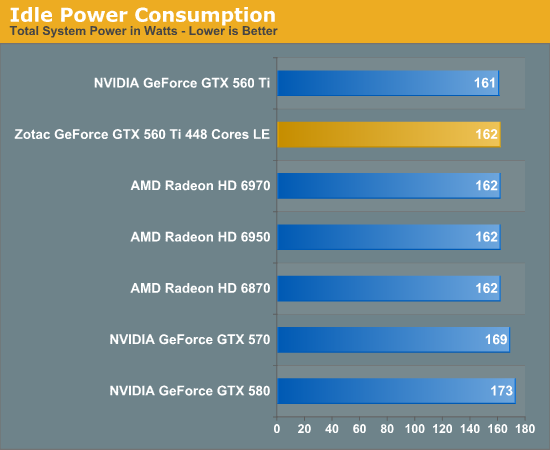
It’s quite interesting to find that idle system power consumption is several watts lower than it is with the GTX 570. Truth be told we don’t have a great explanation for this; there’s the obvious difference in coolers, but it’s rare to see a single fan have this kind of an impact.
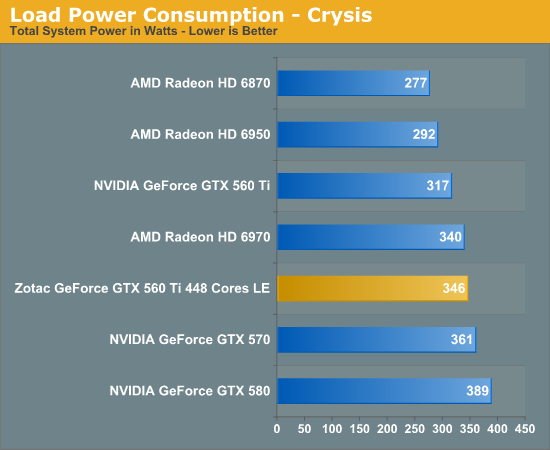
Power consumption under load shows a similar benefit. With the Zotac GTX 560-448 we’re drawing 15W less than with the reference GTX 570. Given that the performance of the Zotac GTX 560-448 is so close to the GTX 570, and this actually starts looking like a cheaper GTX 570 with lower power consumption, which is not something we would have expected to find. But at the same time this means load power consumption is still nearly 30W greater than the GTX 560 Ti, is a very distinct difference for two products sharing the same name.
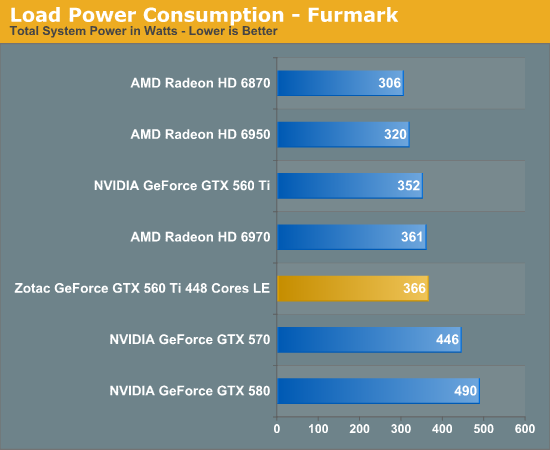
FurMark is thrown in for consistency, but at this point NVIDIA’s driver throttling is so extreme that FurMark is instantly beaten back when started.
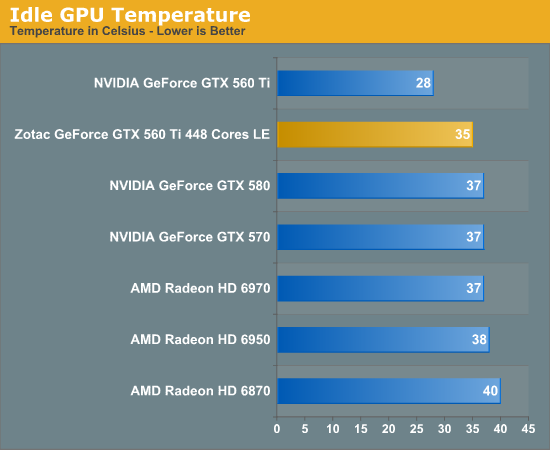
When it comes to GPU temperatures, idle temperatures straddle the difference between the GTX 560 Ti and the GTX 570. The open-air cooler is usually better for lower temperatures, but at the same time GF110’s higher idle power consumption negates some of this benefit. In any case it’s still one of the coolest high-end cards at idle.


Meanwhile GPU load temperatures are at the middle of the pack. Like all GF110 products the Zotac GTX 560-448 starts getting toasty under load (even with the open-air cooler), but it’s still noticeably cooler than the GTX 570 and GTX 580. With that said the open-air cooler means that this is going to be case-dependent, so cases with poor airflow would favor the closed coolers of the GTX 570 and GTX 580.
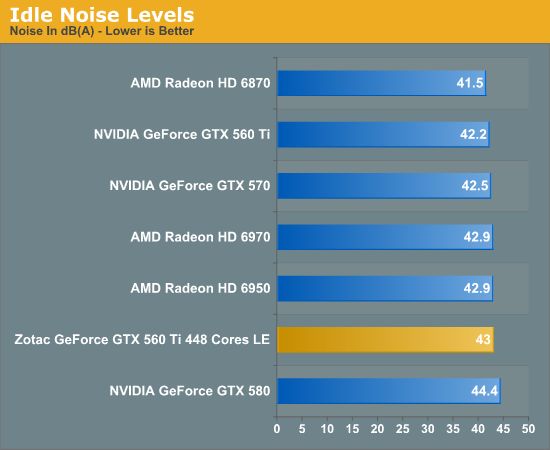

Finally we have our look at noise. The Zotac GTX 560-448 idles just a hair louder than most of our other high-end cards, including the GTX 570. Under load however that open-air cooler really makes its mark among a crowd of closed coolers, leading to noise levels little above the GTX 560 Ti and remarkably quieter than the GTX 570. On a performance/noise spectrum this is fantastic, but the devil is in the details: you need a case with good airflow to make this happen. Otherwise the Zotac GTX 560-448 ramps up significantly once temperatures approach 90C.










80 Comments
View All Comments
ericore - Tuesday, November 29, 2011 - link
This card is the most Perfect example of a corporation trying to milk the consumer.The new Geforce cards are just after Christmas, so what does Nvidia do release a limited addition crap product VS what's around the corner and with a crappy name. The limited namespace is ingenious, but I must hardheadedly agree with Anand on the namespace issue.
Intelligent people will forgot this card, and wait till after Christmas. Nvidia will have no choice to release Graphics card in Q1 because AMD is going to deliver a serious can of whip ass because of their ingenious decision to go with a low power process silicon VS high performance. You see, they've managed to keep the performance but at half the power then add that it is 28nm VS 40nm and what an nerdy orgasm that is. Nvidia will be on their knees, and we may finally see them offer much lower priced cards; so do you buy from the pegger or from the provider? That's a rhetorical question haha.
Revdarian - Tuesday, November 29, 2011 - link
Actually after Christmas you can expect is a 7800 by AMD (that is mid range of the new production, think around or better than current 6900), one month later with luck the high end AMD, and you won't expect the green camp to get a counter until March at the earliest.Now that was said on a Hard website by the owner directly, so i would take it as being very accurate all in all.
ericore - Tuesday, November 29, 2011 - link
HAha, so same performance at half the power + 28nm VS 40nm + potential Rambus memory which is twice as fast, all in all we are looking at -- at least -- double frame rates. Nvidia was an uber fail with their fermi hype. AMD has not hyped the product at all, but rest assure it will be a bomb and in fact is the exact opposite story to fermi. Clever AMD you do me justice in your intelligent business decisions, worthy of my purchase.HStanford1 - Wednesday, December 7, 2011 - link
Can't say the same about their CPU lineupRoflmao
granulated - Tuesday, November 29, 2011 - link
The ad placement under the headline is for the old 384 pipe card !If that isn't an accident I will be seriously annoyed.
DanNeely - Tuesday, November 29, 2011 - link
"It’s quite interesting to find that idle system power consumption is several watts lower than it is with the GTX 570. Truth be told we don’t have a great explanation for this; there’s the obvious difference in coolers, but it’s rare to see a single fan have this kind of an impact."I think it's more likely that Zotak used marginally more efficient power circuitry than on the 570 you're comparing against. 1W there is a 0.6% efficiency edge, 1W on a fan at idle speed is probably at least a 30% difference.
LordSojar - Tuesday, November 29, 2011 - link
Look at all the angry anti-nVidia comments, particularly those about them releasing this card before the GTX 600 series.nVidia is a company. They are here to make money. If you're an uninformed consumer, then you are a company's (no matter what type they are) bread and butter, PERIOD. You people seem to forget companies aren't in the charity business...
As for this card, it's an admirable performer, and a good alternative to the GTX 570. That's all it is.
As for AMD... driver issues or not aside, their control panel is absolutely god awful (and I utilize a system with a fully updated CCC daily). CCC is a totally hilarious joke and should be gutted and redone completely; it's clunky, filled with overlapping/redundant options and ad-ridden. Total garbage... if you even attempt to defend that, you are the very definition of a fanboy.
As for microstutter, AMD's Crossfire is generally worse at first simply because of the lack of frequent CFX profile updates. Once those updates are in place, it's a non issue between the two companies, they both have it in some capacity using dual/tri/quad GPU solutions. Stop jumping around with your red or green pompoms like children.
AMD has fewer overall features at a lower overall price. nVidia has more overall features at a higher overall price. Gee... who saw that coming...? Both companies make respectable GPUs and both have decent drivers, but it's a fact that nVidia tend to have the edge in the driver category while AMD have an edge in the actual hardware design category. One is focused on very streamlined, gaming centric graphics cards while the other is focused on more robust, computing centric graphics cards. Get a clue...
...and let's not even discuss CUDA vs Stream... Stream is total rubbish, and if you don't program, you have no say in countering that point, so please don't even attempt to. Any programmer worth their weight will tell you, quite simply, that for massively parallel workloads where GPU computing has an advantage that CUDA is vastly superior to ANYTHING AMD offers by several orders of magnitude and that nVidia offers far better support in the professional market when compared to AMD.
I'm a user of both products, and personally, I do prefer nVidia, but I try not to condemn people for using AMD products until the moment they try to assert that they got a better deal or condemn me for slightly preferring nVidia due to feature sets. People will choose what they want; power users generally go with nVidia, which does carry a price premium for the premium feature sets. Mainstream and gaming enthusiasts go with AMD, because they are more affordable for every fps you get. Welcome to Graphics 101. Class dismissed.
marklahn - Wednesday, November 30, 2011 - link
Simply put, nvidia has cuda and physx, amd has higher ALU performance which can be beneficial in some scenarios - gogo OpenCL for not being vendor specific though!marklahn - Wednesday, November 30, 2011 - link
Oh and Close to the Metal, brook and stream are all mainly things of the past, so don't bring that up please. ;)Revdarian - Wednesday, November 30, 2011 - link
Such a long post does not make you right, in the part of "CUDA vs Stream" you actually mean "CUDA vs OpenCL and DirectCompute" for example, as those are the two vendor agnostic standards, so that just shows that what is really "rubbish" is your attempt to pose as an authority on the subject.